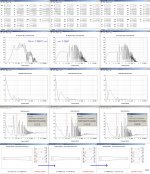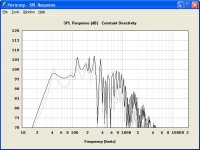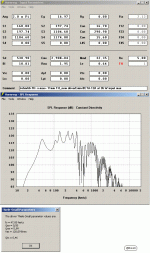I finished building this TH. I am impressed with the output. It is very strong in the 32 to 37Hz range, but seems weak in the 40 to 80Hz range. There is extension down to 29Hz and very little below 27Hz. It is strong above 85Hz. I wish I could boost that middle section. I don't care about going any lower.
Could anyone model this as it is and with a better matched speaker? For now, I just used a speaker I had laying around. Note internal length should read 70-1/2"
Thanks!
Could anyone model this as it is and with a better matched speaker? For now, I just used a speaker I had laying around. Note internal length should read 70-1/2"
Thanks!
An externally hosted image should be here but it was not working when we last tested it.
You haven't given all HR input-parameters. Though it seems to be a pretty uniform flare rate/expansion. S2 is in the middle of the driver, near the closed end. S3 is in the mdiddle of the driver, near the mouth.
I assume you're not in touch with HR yet, this might help: Guide to WinISD Pro and Hornresp - Speakerplans.com Forums - Page 1
You change it into a HR-record and suddenly even lazy people like me don't mind lending a hand
I think I would start with a lower Vas, lower Qes, higher Fs driver.
Best regards Johan
I assume you're not in touch with HR yet, this might help: Guide to WinISD Pro and Hornresp - Speakerplans.com Forums - Page 1
You change it into a HR-record and suddenly even lazy people like me don't mind lending a hand
I think I would start with a lower Vas, lower Qes, higher Fs driver.
Best regards Johan
..I think I would start with a lower Vas, lower Qes, higher Fs driver.
Best regards Johan..
Agree, FYI, A quick plot in HR reveals a lot:
b
Attachments
as others have said, that box/driver combo appears to have issues.
A pa driver would be better suited (3012lf in black, vs your driver)
If you want to keep your driver, moving baffle to 4" for throat side instead of 2" helps some, but it's still kinda ugly.
A pa driver would be better suited (3012lf in black, vs your driver)
If you want to keep your driver, moving baffle to 4" for throat side instead of 2" helps some, but it's still kinda ugly.
Attachments
Hey Guys,
Thank you much for taking the time to look at this TH for me. The modeled curves do seem a bit off from what my ears hear. My function generator reads 33-35Hz when the output is strongest, about 10Hz lower than modeled. The speaker is 20 years old and the foam is about to go, so that might be the reason.
Edit: After more listening, the peak does seem to be at 39-40Hz. Wish I had real testing gear.
I pulled a driver out of another speaker and tried it Fs: 26, Qes .31, Vas 8 Cu/ft. Not ideal, but worth a test. It has better extension into the upper 20Hz range and sounds louder in the 40 Hz range. It still has dead zones. It certainly illustrates how driver parameters affect the horn response.
I can't read the data from the HR runs.
Thank you much for taking the time to look at this TH for me. The modeled curves do seem a bit off from what my ears hear. My function generator reads 33-35Hz when the output is strongest, about 10Hz lower than modeled. The speaker is 20 years old and the foam is about to go, so that might be the reason.
Edit: After more listening, the peak does seem to be at 39-40Hz. Wish I had real testing gear.
I pulled a driver out of another speaker and tried it Fs: 26, Qes .31, Vas 8 Cu/ft. Not ideal, but worth a test. It has better extension into the upper 20Hz range and sounds louder in the 40 Hz range. It still has dead zones. It certainly illustrates how driver parameters affect the horn response.
I can't read the data from the HR runs.
Last edited:
What do you think of this one? Will I lose my sub 30 Hz extension with this PA speaker? It is from Parts Express. I live nearby and can return it to them if I'm not happy, so I'd rather buy through them. This is under $100 and in my price range. Only problem is I can't find any low Qes drivers in my range.
Performance optimized for sound reinforcement systems. Also suitable for lead and bass guitar, keyboards, guitar combos club music systems and stage monitors. Specifications: *Power handling: 250 watts RMS *VCdia: 2" *Le: 0.64 mH *Impedance: 8 ohms *Re: 5.0 ohms *Frequency range: 43-3,800 Hz *Magnet weight: 38 oz. *Fs: 47 Hz *SPL: 98 dB 1W/1m *Vas: 4.2 cu. ft. *Qms: 6.00 *Qes: 0.50 *Qts: 0.46 *Xmax: 4.4 mm *Dimensions: Overall Diameter: 12.03", Cutout Diameter: 10.95", Mounting Depth: 4.57".
Performance optimized for sound reinforcement systems. Also suitable for lead and bass guitar, keyboards, guitar combos club music systems and stage monitors. Specifications: *Power handling: 250 watts RMS *VCdia: 2" *Le: 0.64 mH *Impedance: 8 ohms *Re: 5.0 ohms *Frequency range: 43-3,800 Hz *Magnet weight: 38 oz. *Fs: 47 Hz *SPL: 98 dB 1W/1m *Vas: 4.2 cu. ft. *Qms: 6.00 *Qes: 0.50 *Qts: 0.46 *Xmax: 4.4 mm *Dimensions: Overall Diameter: 12.03", Cutout Diameter: 10.95", Mounting Depth: 4.57".
What do you think of this one?..
Specifications: *Power handling: 250 watts RMS *VCdia: 2" *Le: 0.64 mH *Impedance: 8 ohms *Re: 5.0 ohms *Frequency range: 43-3,800 Hz *Magnet weight: 38 oz. *Fs: 47 Hz *SPL: 98 dB 1W/1m *Vas: 4.2 cu. ft. *Qms: 6.00 *Qes: 0.50 *Qts: 0.46 *Xmax: 4.4 mm *Dimensions: Overall Diameter: 12.03", Cutout Diameter: 10.95", Mounting Depth: 4.57"..
Hi Johnr66,
Sorry, The data given here above is not consistent. Please submitt the brand name and/or usually a pdf specification sheet.
To scale within reason suitable T/S data I provided to match your enclosure:
Use the built in driver select wizard in HR: see the picture where the B&C 12HPL76 12 was found to be a good match.
Parts-Express.com:B&C 12HPL76 12" Neodymium Woofer | bass midbass bass mid neo lightweight DOTW_091509
b
Attachments
Oops. Here is the PDF:
http://www.parts-express.com/pdf/290-408s.pdf
Hi Johnr66,
Sorry,that driver dos'nt suit your TH at all.
b
Attachments
Bjorno, thank you so much for running this TH through HS for me. It looks like I'll have to save up and get the B&C 12HPL76 12" Neodymium Woofer. It looks so beautifully flat through the bass range.
I assume it is the high Q of that other speaker that cause the peaks?
I'll all add a high order low pass to roll it off after 100 Hz. This thing should sound wonderful.
Looks like I'll be eating ramen noodles for a month
I assume it is the high Q of that other speaker that cause the peaks?
I'll all add a high order low pass to roll it off after 100 Hz. This thing should sound wonderful.
Looks like I'll be eating ramen noodles for a month
Bjorno, thank you so much for running this TH through HS for me. It looks like I'll have to save up and get the B&C 12HPL76 12" Neodymium Woofer. It looks so beautifully flat through the bass range.
Hi Johnr66,
A flat FR is sure eye candy but (IMO) even more useful is a gentle sloping FR, aligned to the existing 'wall-gain' but that was not the primary target when I looked for a suitable driver T/S parameters, instead it was to achieve a good smooth in band phase (group delay) behavior in the pass band:
TH:s can be tricky to integrate with the main (home) speakers if the gldy is more than about 9.4 mS at 80 Hz i.e. a phase issue as most bass-amps used cannot compensate pure time lapsed signal delays or inevitable large phase rotating exceeding nearly a full 360 degree circle at the XO point.
I assume it is the high Q of that other speaker that cause the peaks?
Driver Q is only partly the reason: the driver you suggested, the EminenceBETA12A-2 is performing better in a more suitable box
I'll all add a high order low pass to roll it off after 100 Hz. This thing should sound wonderful..
My experience with (not of my designs) DIY TH: s (large constant gldy that has to be cured with signal delaying of the mains) is box structural noise emissions (improperly placed bracings), internal wall reflections sounds (no sink of the excess spectra energy not needed for a sub to reproduce and mechanical sounds from flimsy mounted drivers revealing where the sub is placed, clearly heard at the pre ringing time history of a system transient, rather than inadequate LP signal filtering of the excess BW.
IMO, A 12-24 dB LP filter should be quite adequate.
Looks like I'll be eating ramen noodles for a month
b
Attachments
The Eminence Kappa Pro-12 or 12A will work if the published specs are fairly accurate: Eminence | KAPPA PRO-12A - 1000W 12" (304.8mm) | KAPPA-12A
GM
GM
Originally Posted by johnr66
Looks like I'll be eating ramen noodles for a month
Hi Johnr66,
It looks like you can skip the noodels as GM found a very suitable and inexpensive driver:
b
Attachments
Nice work guys!
If I'm reading the graphs correctly, It looks like the B&C speaker plays about 3 or 4 db louder then the Kappa Pro in the desired range and group delay with the B&C is a wee bit better, right?
I just found out that I'm getting $226 back from taxes, so the B&C driver is starting to look interesting.
John

If I'm reading the graphs correctly, It looks like the B&C speaker plays about 3 or 4 db louder then the Kappa Pro in the desired range and group delay with the B&C is a wee bit better, right?
I just found out that I'm getting $226 back from taxes, so the B&C driver is starting to look interesting.
John
I went to Parts Express today. I live near by and they have a showroom. I bought the B&C 12HPL76 driver.
After popping it into the horn, this is what I notice. The low peaks are gone and extension reaches down to the mid 20s. The other speaker wasn't really producing anything useful below 28 or 29Hz. The weak areas in the mid bass (around 50Hz) are now filled in. It can handle rock bass lines now. Chalk another one up for Horn Responce. It seems to have worked out well in taming this beast.
These pro sound speakers can reproduce higher frequency sounds, so I need to get this thing crossed over. I was surprised that this speaker uses a thin paper cone like the old console stereos or guitar speakers do.
Thanks guys, especially bjorno for all your help.
John
After popping it into the horn, this is what I notice. The low peaks are gone and extension reaches down to the mid 20s. The other speaker wasn't really producing anything useful below 28 or 29Hz. The weak areas in the mid bass (around 50Hz) are now filled in. It can handle rock bass lines now. Chalk another one up for Horn Responce. It seems to have worked out well in taming this beast.
These pro sound speakers can reproduce higher frequency sounds, so I need to get this thing crossed over. I was surprised that this speaker uses a thin paper cone like the old console stereos or guitar speakers do.
Thanks guys, especially bjorno for all your help.
John
Hi Johnr66,
[...]
Use the built in driver select wizard in HR:
b
I can't find that wizard.
I have version 26.20. Is it me, or do I need to update already?
Thanks,
Dane
- Status
- This old topic is closed. If you want to reopen this topic, contact a moderator using the "Report Post" button.
- Home
- Loudspeakers
- Subwoofers
- Can anyone help me tame this 6' beast?






